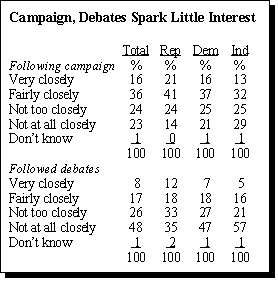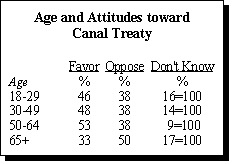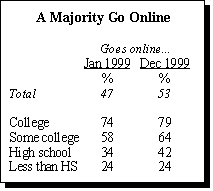The Public Remains Disconnected
In spite of the accelerated pace of the 2000 presidential campaign, only 16% of the public is following news about candidates very closely. Interest in the campaign has not meaningfully increased since July, despite competitive contests for both parties’ nominations.
Even fewer Americans closely followed the recent GOP candidate debates. Less than one-in-ten (8%) have followed the debates very closely; fully 48% haven’t followed them at all. Even among Republicans, interest in the debates has been low: 12% have followed very closely.

Lack of interest in the campaign is reflected as well in the public’s inattentiveness to several recent campaign developments. Only about one-third (36%) of the public heard about Al Gore hiring Naomi Wolf as a campaign advisor. Just 51% of Americans know that Bill Bradley was a professional basketball player before entering politics. And similarly small majorities have heard reports about John McCain’s temper (53%) and his experience as a prisoner of war in Vietnam (55%). Slightly more (59%) heard about George W. Bush’s inability to name foreign leaders in a pop quiz posed by a television reporter. Even so, fully 41% of Americans did not hear about this widely reported event.
In addition, the public is having difficulty associating key themes and issues with the candidates who are advocating them. Less than one-third of Americans (29%) have heard about “compassionate conservatism,” which is Bush’s campaign theme. Only 15% associate this phrase with the Texas governor. While Republicans are slightly more likely than Democrats and Independents to have heard about compassionate conservatism, 60% of GOP loyalists are unfamiliar with this phrase.
Americans are more aware of other issues and themes tested in the poll, however, they are less clear about which candidates to associate with those issues. More than three-quarters (79%) of Americans say they have heard the candidates talking about providing health insurance to people currently uninsured. Yet Bradley, who has made this issue central to his campaign, receives very little credit for it. Only 9% of the public associates the former New Jersey senator with expanding health care coverage. Voters are just as likely to associate Bush with this issue. Gore is seen by about one-third of the public (31%) as championing this issue.
Roughly seven-in-ten Americans (72%) have heard the candidates talking about tax cuts targeted at lower and middle-income groups. One-in-five (22%) associate this issue with Bush, who has made tax cuts a centerpiece of his campaign. Another 12% links Gore with this issue.
Though campaign finance reform has been a primary focus of McCain’s Senate career, as well as his presidential campaign, very few Americans associate the Arizona senator with this issue. Fully 61% of the public has heard this issue discussed over the course of the campaign, but only 11% credits McCain.

By and large, these campaign events and issues have had little bearing on voter preferences. Whether the subject is Bush’s failed pop quiz, his theme of compassionate conservatism or his tax cut plan, none of these items have a statistically significant relationship to support for him among GOP voters. Similarly, Democratic voters who heard about Gore’s hiring of Naomi Wolf are no more or less likely to support the vice president in his nomination race with Bradley.
There are a few important exceptions to this pattern. Certain facts about the candidates, relating to their life stories, do seem to make a difference. Taking into account other factors that might influence support for McCain, Republican voters who have heard about the senator’s experiences as a POW in Vietnam are more likely than those who have not heard about this to support McCain for the GOP nomination. Perhaps surprisingly, those who are aware that McCain is reported to have a temper are also more likely to support him in the nomination race.
For Bradley, his experience as a basketball player is a real plus, at least among those Democrats who are aware of his years as a New York Knick. Holding constant other factors, Democratic voters who know that Bradley played in the NBA are more likely to support him for their party’s nomination than those who don’t know this.
Bush Seen as Qualified
General impressions of the candidates — perceptions of their qualifications, their positions and their personalities — are more closely linked to support for their campaigns than the issues and events discussed above. Overall, the public views Bush, McCain, Gore and Bradley as qualified to be president. There is no evidence in this poll to suggest that Bush is seen as lacking in stature or experience. If anything, the Texas governor is seen as the most qualified candidate in the group. Gore is not viewed as being any more qualified than Bradley.
By and large, the public gives the candidates high marks for their stands on the issues and for being personally likeable. However, Gore lags behind on both of the qualities. Six-in-ten (61%) of those able to rate the vice president say he has good positions on the issues. This compares with 70% or better for Bradley, McCain and Bush. Similarly, 67% find Gore personally likeable compared to 80% or better for the other three contenders.

In most cases, candidate qualifications matter more than issue positions in determining whom voters support. Among Republican voters, assessments of Bush’s qualifications are more closely linked to his support than are feelings about his stands on the issues or views of him personally. The same is true for McCain and, among Democratic voters, for Bradley.
For Gore, however, personality matters almost as much as qualifications. Whether or not Democratic voters see Gore as personally likeable is nearly as strong a predictor of support for Gore as are voters’ assessments of his qualifications. Overall, Gore is seen as being less likeable than Bradley.
Modest Support for Canal Treaty
More than two decades after the bitter political debate over the Panama Canal treaty, Americans remain divided over the prospect of actually turning the canal over to Panama. With the Dec. 31 deadline for transferring the canal approaching, 46% say they favor the treaty, against 40% who oppose the agreement. Not much has changed in public attitudes on this subject since the Senate ratified the treaties in 1978. In February of that year, shortly before the Senate debate, 43% favored the pact, with 38% opposed.
While control over the canal has receded as a political issue, most of those surveyed (60%) are aware that the official turnover will take place at year’s end. But there is a clear generation gap in terms of support for the treaty between senior citizens and younger Americans.

Three-quarters (76%) of those aged 65 and over say they have heard about the canal transfer. But half of those 65 and older oppose the agreement — the only age group in which opponents outnumber supporters — while 33% favor it. Among those 65 and older who know about the transfer, opposition is even more lopsided, with 58% opposed and just 35% in favor. People under age 50 tend to be less aware, but more supportive, of the transfer and treaty.
Almost as many Americans in the 50-64 age group (74%) as in the older group are aware that the United States is about to relinquish control over the canal. But people in this category have a more favorable impression of the treaty, supporting it 53% to 38%. Among 18-29 year-olds, who either were not born when the canal debate raged or were probably too young to remember it, only 42% are aware of the transfer — the lowest percentage of any age group. But this group also favors the treaty, 46% to 38%. And those in this category who have heard of the transfer support the treaty by a 2-to-1 margin, 62% to 31%.
Conservative Republicans vehemently opposed the treaty in the late 1970s, and many Republicans still harbor doubts about the pact. Republicans are generally more aware of the canal transfer than Democrats (69% to 56%). Republicans narrowly favor the treaty (47% to 44%) while Democrats support it by a wider margin (49% to 36%).
Optimism Reigns
Americans look back at 1999 with satisfaction and approach the start of the 21st century with high hopes. Two-thirds (66%) believe 2000 will be better than 1999, up from 59% last year and the highest percentage since the question was first posed by Gallup in 1981.

This has been a good year for most Americans personally, and, despite an unpopular presidential impeachment, a slim majority considers 1999 to have been a good year for the nation. When asked to assess 1999 from a personal standpoint, nearly three-quarters (74%) consider it a good year, approximately the same as last year. That percentage declines to 57% — also similar to last year’s result — when people consider how well the country fared in 1999.
An overwhelming majority (86%) of those in the highest annual income bracket — $75,000 or more — say 1999 has been good for them; a smaller but healthy majority (64%) of those making $20,000 or less agree. Optimism dampens only slightly when predicting what 2000 will bring: 75% of the high income group believes the new year will be better than 1999, compared to 60% of those with the lowest incomes.
Men have a more positive assessment of 1999 than women. Two-thirds (66%) of men say 1999 has been good for the country compared to less than half (49%) of women. And a strong majority (72%) of men say 2000 will be better than 1999 while 61% of women agree.

As the millennium approaches, Americans are increasingly blasé about the start of the new century. Only 23% say the year 2000 has special significance, down 10 percentage points from April of this year. Nearly three-quarters (74%) are indifferent about 2000: They say it is just another year on the calendar.
News Interest Index
Reports of the crash of EgyptAir flight 990 and the investigation into what happened topped the news interest index for the month. Three-in-ten people say they followed news about the crash very closely. Just 18% say the same of the failure of the Mars Polar Lander spacecraft to send data back to Earth.
News about the protests at the World Trade Organization meeting in Seattle captured the attention of one-in-five Americans (18%), with people in the West expressing the greatest interest in the story. Fewer people followed coverage of the agreement allowing China to join the WTO (12%), although more members of labor union households followed news of the agreement with China at least fairly closely (50%) than did those in non-union households (39%).
Only one-in-ten people (11%) say they followed reports of the antitrust trial against Microsoft, relatively unchanged from interest in this story in November 1998. Attention to news about the lawsuit was higher among those who go online than those who do not (52% vs. 32%, respectively, say they followed it at least fairly closely).
Just 11% of Americans say they paid any attention to news about the fighting between the Russian military and rebels in Chechnya. Interest in the conflict has changed little since it was measured four years ago. More men than women say they followed coverage of Russian military action in the area at least fairly closely (16% vs. 7%).
E-shopping Expansion
The number of people purchasing goods or services over the Internet has increased significantly over the past year. Nearly three-in-ten (28%) say they have made a purchase online, up from 17% at the beginning of the year, while almost one-in-five (19%) say they have made a purchase within the last month. Among the more affluent and better educated Americans, more than half (61% and 55%, respectively) say they have bought something over the Internet.

More generally, the year ends with a majority of Americans going online (53%), up from 47% in January 1999. Continuing the trend toward a broadening of the Internet population, the increase was slightly greater among those with only a high school degree (up 8 percentage points) than among those with a college degree (up 5 percentage points). Likewise, the largest gains in going online by income were among those earning less than $20,000 a year (34% up from 22% in January). Overall, the largest increase in online usage over the past year was among men ages 18-29 (82% up from 66%).
Genetically-Altered Foods Little Known
Most Americans know little about genetically-altered foods yet they overwhelmingly support labeling such products. The vast majority — 84% — wants the Food and Drug Administration to require labels identifying products that have been genetically-altered to taste better, last longer, or increase crop yields. Those who have heard a lot about this subject and even those who have purchased genetically-altered foods agree that labels are needed.
About half (49%) of Americans have heard at least something about genetically-altered foods. Half also say that, to their knowledge, they have never bought such foods, and a plurality — 40% — don’t know whether their grocer stocks these items. Yet news reports paint a different picture. American grocery stores do carry many genetically-altered products and people have most likely eaten such foods whether they are aware of it or not, according to recent news reports in Time magazine and elsewhere.
Men, college graduates, and those with higher incomes tend to be more aware of genetically-altered foods and somewhat less concerned about them. While 28% of men say they have bought these foods, only 17% of women agree. Yet 90% of women want the FDA to require labels, compared to 77% of men.
Among college graduates, 35% say their grocer sells modified foods and 73% support labeling. Among those who have completed high school, those figures are 20% and 89%, respectively. Almost one-third (32%) of those with at least a $75,000 annual income say they have bought genetically-altered foods, compared to just 18% of those making $20,000 or less. Three-quarters of those in the highest income bracket want these foods labeled while 88% of those making $20,000 or less want labels.

An overwhelming majority, regardless of whether or not they have heard a lot about genetically-altered foods or have consumed such products, wants labels. Of the relatively small group that has heard a lot about this subject, nearly three-quarters (74%) support labeling. Similarly, most people (72%) who say they have bought genetically-altered foods want the FDA to require labels. By contrast, almost nine-in-ten Americans (89%) who have heard nothing at all about genetically-altered foods want labels. Of those who say they are not aware of purchasing genetically-altered foods, 90% support labeling.




